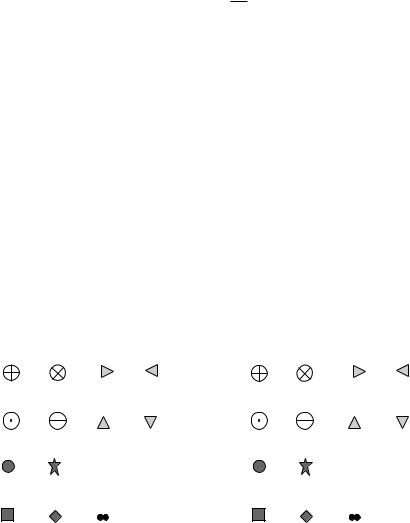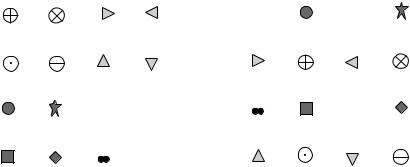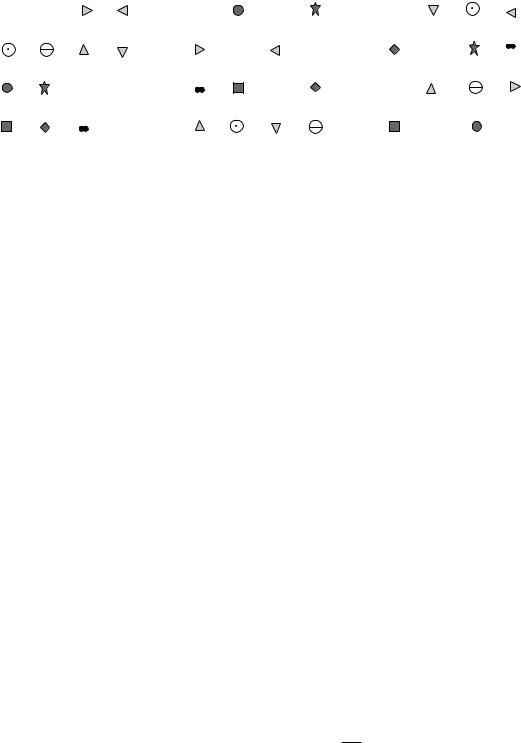
Fundamentals Of Wireless Communication
.pdf
398 |
MIMO III: diversity–multiplexing tradeoff and universal space-time codes |
easy to compute d. A nr ×nt matrix H of rank r is described by rnt + nr −r r parameters: rnt parameters to specify r linearly independent row vectors of H and nr −r r parameters to specify the remaining nr −r rows in terms of linear combinations of the first r row vectors. Hence r is ntr + nr −r r-dimensional and the number of dimensions orthogonal to r in nt nr is simply
ntnr − ntr + nr − r r = nt − r nr − r
This is precisely the SNR exponent of the outage probability in (9.32).
9.2 Universal code design for optimal diversity–multiplexing tradeoff
The operational interpretation of the outage formulation is based on the existence of universal codes that can achieve arbitrarily small error whenever the channel is not in outage. To achieve such performance, arbitrarily long block lengths and powerful codes are required. In the high SNR regime, we have seen in Chapter 3 that the typical error event is the event that the channel is in a deep fade, where the deep-fade event depends on the channel as well as the scheme. This leads to a natural high SNR relaxation of the universality concept:
A scheme is approximately universal if it is in deep fade only when the channel itself is in outage.
Being approximately universal is sufficient for a scheme to achieve the diversity–multiplexing tradeoff of the channel. Moreover, one can explicitly construct approximately universal schemes of short block lengths. We describe this approach towards optimal diversity–multiplexing tradeoff code design in this section. We start with the scalar channel and progress towards more complex models, culminating in the general nt × nr MIMO channel.
9.2.1 QAM is approximately universal for scalar channels
In Section 9.1.2 we have seen that uncoded QAM achieves the optimal diversity–multiplexing tradeoff of the scalar Rayleigh fading channel. One can obtain a deeper understanding of why this is so via a typical error event analysis. Conditional on the channel gain h, the probability of error of uncoded QAM at data rate R is approximately
Q |
SNR |
h 2dmin2 |
|
(9.33) |
2 |

399 |
9.2 Universal code design for optimal diversity–multiplexing tradeoff |
where dmin is the minimum distance between two normalized constellation points, given by
|
|
|
dmin ≈ |
1 |
|
|
(9.34) |
|
2R/ |
2 |
|||||
When |
√ |
|
h dmin 1, i.e. the separation |
of the constellation points |
|||
SNR |
|||||||
at the receiver is much larger than the standard deviation of the additive Gaussian noise, errors occur very rarely due to the very rapid drop off of the Gaussian tail probability. Thus, as an order-of-magnitude approximation, errors typically occur due to:
Deep-fade event h 2 < |
2R |
(9.35) |
|
|
|
||
SNR |
|||
|
|
|
|
This deep-fade event is analogous to that of BPSK in Section 3.1.2. On the other hand, the channel outage condition is given by
log 1 + h 2SNR < R |
(9.36) |
or equivalently
R |
|
h 2 < 2SNR− 1 |
(9.37) |
At high SNR and high rate, the channel outage condition (9.37) and the deepfade event of QAM (9.35) coincide. Thus, typically errors occur for QAM only when the channel is in outage. Since the optimal diversity–multiplexing tradeoff is determined by the outage probability of the channel, this explains why QAM achieves the optimal tradeoff. (A rigorous proof of the tradeoff optimality of QAM based solely on this typical error event view is carried out in Exercise 9.9, which is the generalization of Exercise 3.3 where we used the typical error event to analyze classical diversity gain.)
In Section 9.1.2, the diversity–multiplexing tradeoff of QAM is computed by averaging the error probability over the Rayleigh fading. It happens to be equal to the optimal tradeoff. The present explanation based on relating the deep-fade event of QAM and the outage condition is more insightful. For one thing, this explanation is in terms of conditions on the channel gain h and has nothing to do with the distribution of h. This means that QAM achieves the optimal diversity–multiplexing tradeoff not only under Rayleigh fading but in fact under any channel statistics. This is the true meaning of universality. For example, for a channel with the near-zero behavior of h 2 < ≈ k, the optimal diversity–multiplexing tradeoff curve follows directly from (9.15): d r = k 1 − r . Uncoded QAM on this channel can achieve this tradeoff as well.

400 |
MIMO III: diversity–multiplexing tradeoff and universal space-time codes |
Note that the approximate universality of QAM depends only on a condition on its normalized minimum distance:
dmin2 > |
1 |
|
|
(9.38) |
|
||||
2R |
|
|
|
|
Any other constellation with this property is also approximately universal (Exercise 9.9).
Summary 9.1 Approximate universality
A scheme is approximately universal if it is in deep fade only when the
channel itself is in outage.
Being approximately universal is sufficient for a scheme to achieve the diversity–multiplexing tradeoff of the channel.
9.2.2 Universal code design for parallel channels
In Section 3.2.2 we derived design criteria for codes that have a good coding gain while extracting the maximum diversity from the parallel channel. The criterion was derived based on averaging the error probability over the statistics of the fading channel. For example, the i.i.d. Rayleigh fading parallel channel yielded the product distance criterion (cf. Summary 3.1). In this section, we consider instead a universal design criterion based on considering the performance of the code over the worst-case channel that is not in outage. Somewhat surprisingly, this universal code design criterion reduces to the product distance criterion at high SNR. Using this universal design criterion, we can characterize codes that are approximately universal using the idea of typical error event used in the last section.
Universal code design criterion
We begin with the parallel channel with L diversity branches, focusing on just one time symbol (and dropping the time index):
y = h x + w |
(9.39) |
for = 1 L. Here, as before, the w are i.i.d. 0 1 noise. Suppose the rate of communication is R bits/s/Hz per sub-channel. Each codeword is a vector of length L. The th component of any codeword is transmitted over the th sub-channel in (9.39). Here, a codeword consists of one symbol for each of the L sub-channels; more generally, we can consider coding over multiple symbols for each of the sub-channels as well as coding across the




404 |
MIMO III: diversity–multiplexing tradeoff and universal space-time codes |
Thus, the universal code design problem is to choose the codewords maximizing the pairwise product distance; in this regime, the criterion coincides with that of the i.i.d. Rayleigh parallel fading channel (cf. Section 3.2.2).
Property of an approximately universal code
We can use the universal code design criterion developed above to characterize the property of a code that makes it approximately universal over the parallel channel at high SNR. Following the approach in Section 9.2.1, we first define a pairwise typical error event: this is when the argument of the Q√·/2 in (9.41) is less than 1:
|
L |
|
|
|
SNR · |
|
h 2 |
d 2 < 1 |
(9.52) |
|
=1
For a code to be approximately universal, we want this event to occur only when the channel is in outage; equivalently, this event should not occur whenever the channel is not in outage. This translates to saying that the worst-case code design criterion derived above should be greater than 1. At high SNR, using (9.51), the condition becomes
d1d2 · · · dL 2/L > |
1 |
|
(9.53) |
L2R |
Moreover, this condition should hold for any pair of codewords. It is verified in Exercise 9.14 that this is sufficient to guarantee that a coding scheme achieves the optimal diversity–multiplexing tradeoff of the parallel channel.
We saw the permutation code in Figure 9.13 as an example of a code with good universal design criterion value. This class of codes contains approximately universal codes. To see this, we first need to generalize the essential structure in the permutation code example in Figure 9.13 to higher rates and to more than two sub-channels. We consider codes of just a single block length to carry out the following generalization.
We fix the constellation from which the codeword is chosen in each subchannel to be a QAM. Each of these QAM constellations contains the entire information to be transmitted: so, the total number of points in the QAM constellation is 2LR if R is the data rate per sub-channel. The overall code is specified by the maps between the QAM points for each of the sub-channels. Since the maps are one-to-one, they can be represented by permutations of the QAM points. In particular, the code is specified by L − 1 permutations2 L: for each message, say m, we identify one of the QAM points, say q, in the QAM constellation for the first sub-channel. Then, to convey the message m, the transmit codeword is
q 2q Lq


406 MIMO III: diversity–multiplexing tradeoff and universal space-time codes
or |
|
h1 2SNR > 22R |
(9.56) |
However, we do not need to use just the first I sub-channel to recover all the information bits: the second I sub-channel also contains the same information and can be used in the recovery process. Indeed, if we create x1I by treating the ordered R bits as the binary representation of the points x1I , then one would intuitively expect that if
h1 2SNR > 22R1 |
(9.57) |
then one should be able to recover at least R1 of the most significant bits of information. Now, if we create x2I by treating the reversal of the R bits as its binary representation, then one should be able to recover at least R2 of the most significant bits, if
h2 2SNR > 22R2 |
(9.58) |
But due to the reversal, the most significant bits in the representation in the second I sub-channel are the least significant bits in the representation in the first I sub-channel. Hence, as long as R1 + R2 ≥ R, then we can recover all R bits. This translates to the condition
log h1 2SNR + log h2 2SNR > 2R |
(9.59) |
which is precisely the no-outage condition (9.54) at high SNR.
The bit-reversal scheme described here with some slight modifications can be shown to be approximately universal (Exercise 9.16). A simple variant of this scheme is also approximately universal (Exercise 9.17).
Summary 9.2 Universal codes for the parallel channel
A universal code design criterion between two codewords can be computed by finding the channel not in outage that yields the worst-case pairwise error probability.
At high SNR and high rate, the universal code design criterion becomes proportional to the product distance:
d1 dL 2/L |
(9.60) |
where L is the number of sub-channels and d is the difference between the th components of the codewords.

407 |
9.2 Universal code design for optimal diversity–multiplexing tradeoff |
A code is approximately universal for the parallel channel if its product distance is large enough: for a code at a data rate of R bits/s/Hz per sub-channel, we require
d1d2 · · · dL 2 > |
1 |
|
(9.61) |
L2R L |
Simple bit-reversal schemes are approximately universal for the 2-parallel channel. Random permutation codes are approximately universal for the L-parallel channel with high probability.
9.2.3 Universal code design for MISO channels
The outage event for the nt × 1 MISO channel (9.22) is |
|
||
log 1 + h 2 |
SNR |
< R |
(9.62) |
|
|||
nt |
|||
In the case when nt = 2, the Alamouti scheme converts the MISO channel to a scalar channel with gain h and SNR reduced by a factor of 2. Hence, the outage behavior is exactly the same as in the original MISO channel, and the Alamouti scheme provides a universal conversion of the 2 × 1 MISO channel to a scalar channel. Any approximately universal scheme for the scalar channel, such as QAM, when used in conjunction with the Alamouti scheme is also approximately optimal for the MISO channel and achieves its diversity–multiplexing tradeoff.
In the general case when the number of transmit antennas is greater than two, there is no equivalence of the Alamouti scheme. Here we explore two approaches to constructing universal schemes for the general MISO channel.
MISO channel viewed as a parallel channel
Using one transmit antenna at a time converts the MISO channel into a parallel channel. We have used this conversion in conjunction with repetition coding to argue the classical diversity gain of the MISO channel (cf. Section 3.3.2). Replacing the repetition code with an appropriate parallel channel code (such as the bit-reversal scheme from Section 9.2.2), we will see that converting the MISO channel into a parallel channel is actually tradeoff-optimal for the i.i.d. Rayleigh fading channel.
Suppose we want to communicate at rate R = r log SNR bits/s/Hz on the MISO channel. Using one transmit antenna at a time yields a parallel channel with nt diversity branches and the data rate of communication is R bits/s/Hz per sub-channel. The optimal diversity gain for the i.i.d. Rayleigh parallel fading channel is nt 1 − r (cf. (9.20)); thus, using one antenna at a
